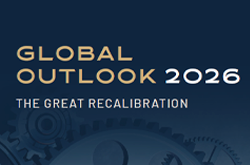Searching for a new inflation regime
Download the Indosuez 2024 Global Outlook here
2022 was a year of shocks on inflation and central banks’ interest rates, and while 2023 has seen volatility in bonds, the year has been marked by the unexpected resilience of the US economy. A US recession seemed inevitable as the Federal Reserve (Fed) engineered the fastest tightening cycle in four decades. The US GDP forecast for 2023 stood at 0.3% in January and is likely to end at 2.3% for the year. Throughout, we never fell into the pessimistic camp, moving from a mild contraction to a stabilisation of growth around 1.2% for 2024. The US consumer, thanks to excess savings, wage growth above inflation and a very supportive employment market, remained very resilient throughout the year.
TOWARDS A NEW EQUILIBRIUM
After the Great Financial Crisis of 2008, an era of low inflation, low to negative interest rates, and predictable central bank policy opened and seemed to last forever. To quote German economist Rüdiger Dornbusch: “In economics things take longer to happen than you think they will, and then they happen faster than you thought they could”. The brutal adjustment that took place after the COVID-19 crisis saw a massive return of inflation and central banks rushing to combat this abrupt transition they had not seen coming. This led to an astonishing 520 rate hikes throughout the world in the last 24 months.
Amidst these changes, the biggest victim in financial markets for the third year running has been the bond market. US Treasuries, especially long dated bonds, have become risky assets whose price return characteristics suddenly look like equities. For example, the financial instrument TLT tracking 20 year Treasuries has lost more than half of its value since 2020. A government bond issued in 2020 by Austria with 100-year maturity and a 0.75% coupon, lost as much as 70% in 2023.
However, this represents a great investment opportunity. Fixed income now offers much needed attractive yields. Investors have channelled large amounts of money to take advantage of this situation: the TLT mentioned above saw its assets doubled over the same timeframe. However, the medium part of the curve around five years remains a sweet spot of attractive yield and lower price volatility.
THE ONE TRILLION COST
Looking towards 2024, the massive amount of government debt will become a focal point of attention. At the time of writing, the US is running a deficit close to USD 34 trillion, costing it USD 1 trillion a year or 14% of the Federal budget. This is clearly not sustainable, and interest rates will soon find a ceiling, if they have not found one already. While the notion of a form of protection for equity investors through the so called “Fed put”, a new form of a Fed put this time on bonds might emerge. Whether it takes the form of Quantitative Easing (QE), Yield Curve Control (YCC) like in Japan, or emergency intervention like the Bank of England in 2022, central banks are never short of options, especially when it comes to stabilising financial markets.
The disinflation process is under way, but it won’t be linear. A return to low inflation is out of the picture, as institutions would prefer a continual fine dose of inflation.
This is an inconvenient truth that central banks often avoid publicising. Indeed, “engineering a higher nominal GDP growth through a higher structural level of inflation is a proven way to get rid of high levels of debt”, according to market strategist Russell Nappier. Governments will have to engineer a level of nominal growth and of inflation that is consistently somewhat higher than interest rates in order to shrink the debt to GDP ratio. Since mid-2020, US nominal GDP growth has gone up by 40%. This also explains why developed market equities, especially in the US, have continued to perform well, as margins remain resilient and companies’ sales are tracking inflation, thus growing on a nominal basis and offering some form of inflation insulation. In essence, we have to move away from high inflation, avoid stagflation, and reach a reflation regime.
This is the topic we will cover in this Global Outlook edition with our experts. Understanding the implications of a new inflation (and growth) regime, which is set to reshape strategic asset allocation, wherein both bonds and equities settle into a healthier balance after years of zero interest rates.
A last word on Environmental, Social and Governance (ESG). The needs of the energy transition have never been more relevant, as “2023 is virtually certain to be the warmest year on record”. Sustainable finance, however, is under attack as performances on many sustainable solutions have disappointed. “ESG bashing” is becoming more commonplace, but we should avoid falling too deeply in the pessimistic camp. Indeed, climate inaction would be twice as costly as the investments needed to make the transition to carbon neutrality by 2050. This offers a clear and com- pelling investment opportunity.
Editorial of the Indosuez Global Outlook by CIO Alexandre Drabowicz, release of 04/12/2023
December 18, 2023


